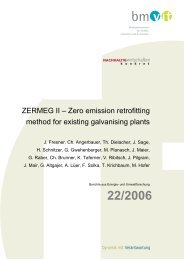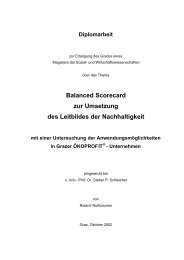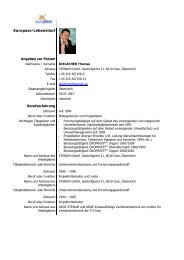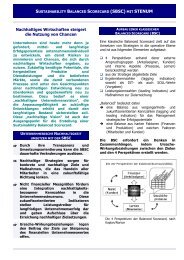Promoting Resource Efficiency in Small & Medium size ... - UNEP
Promoting Resource Efficiency in Small & Medium size ... - UNEP
Promoting Resource Efficiency in Small & Medium size ... - UNEP
Create successful ePaper yourself
Turn your PDF publications into a flip-book with our unique Google optimized e-Paper software.
personal protection devices (e.g. a towel wrapped around face)<br />
• Places <strong>in</strong> the factory where workers compla<strong>in</strong> about health effects,<br />
loss of consciousness, etc.<br />
• Incidents of fire, explosion or accident <strong>in</strong> the past year<br />
• Ignition sources such as heat / sparks / open flames <strong>in</strong> the<br />
neighbourhood of flammable liquids / gases / dusts conta<strong>in</strong>ers<br />
that are labelled with hazard symbols<br />
• Situations where the sk<strong>in</strong> of workers is contam<strong>in</strong>ated with<br />
chemicals<br />
• Spoiled or expired chemicals<br />
• Situations where workers do not have appropriate tools for mix<strong>in</strong>g,<br />
weigh<strong>in</strong>g, transportation, etc. 93<br />
3: Identify risk-prone and vulnerable groups, areas and assets <strong>in</strong> case of<br />
an accident<br />
This step is all about identify<strong>in</strong>g threatened people, environment and/or<br />
property. In case of an accident, ask yourself the follow<strong>in</strong>g questions and<br />
discuss them <strong>in</strong> the team:<br />
• How many workers are undertak<strong>in</strong>g activities where hazardous<br />
chemicals are <strong>in</strong>volved?<br />
• How many workers are undertak<strong>in</strong>g activities near areas where<br />
hazardous chemicals are be<strong>in</strong>g handled or stored?<br />
• Are activities tak<strong>in</strong>g place <strong>in</strong> an area of high population density?<br />
• Are there any hospitals, schools, markets or shopp<strong>in</strong>g areas<br />
located nearby?<br />
• Are hazardous chemicals be<strong>in</strong>g handled, stored, processed or<br />
used <strong>in</strong> or nearby:<br />
- Areas prone to flood<strong>in</strong>g?<br />
- Agricultural areas?<br />
- Areas where water for dr<strong>in</strong>k<strong>in</strong>g, agricultural or recreational use<br />
is resourced?<br />
- Nature protection areas?<br />
4: Identify potential accident scenarios related to the hazard hotspots you<br />
have identified<br />
Review<strong>in</strong>g and analys<strong>in</strong>g past accidents from your bus<strong>in</strong>ess and with<strong>in</strong><br />
your <strong>in</strong>dustry will be extremely helpful for avoid<strong>in</strong>g future accidents.<br />
Recall<strong>in</strong>g well-known accidents <strong>in</strong> the sector may also help you <strong>in</strong><br />
identify<strong>in</strong>g potential types of accidents (or ‘accident scenarios’) related<br />
to the hotspots you have already identified.<br />
Tak<strong>in</strong>g <strong>in</strong>to account the types and quantities of hazardous chemicals<br />
<strong>in</strong>volved <strong>in</strong> each of the steps on your process flowchart, try to list<br />
potential accidents related to the hazard hotspots you have already<br />
identified.<br />
You may want to consider the follow<strong>in</strong>g types of accidents (or ‘accident<br />
scenarios’), and check if any of the hazards you have identified could<br />
have the potential to trigger or contribute to such an event:<br />
• Conta<strong>in</strong>ment failures due to corrosion, metal fatigue, creep,<br />
embrittlement or poor water management<br />
• Toxic release<br />
• Emission of toxic or irritant gases or fumes<br />
• Explosions: unconf<strong>in</strong>ed vapour cloud explosion (UVCE),<br />
boil<strong>in</strong>g liquid expand<strong>in</strong>g vapour explosion (BLEVE), chemical<br />
explosion, dust explosion<br />
• Explosion or fire from the handl<strong>in</strong>g of <strong>in</strong>flammable gases <strong>in</strong><br />
liquid form<br />
• Chemical fire produc<strong>in</strong>g harmful gases<br />
• Chemical fire lead<strong>in</strong>g to polluted water escap<strong>in</strong>g as a result of<br />
attempts to ext<strong>in</strong>guish the fire<br />
• Leakage of hazardous chemicals from storage and process areas,<br />
or dur<strong>in</strong>g transport<br />
• Other (discuss among the risk assessment team)<br />
5: Identify the severity of related health, environmental, social and<br />
economic impacts <strong>in</strong> an accident situation<br />
Tak<strong>in</strong>g <strong>in</strong>to account the quantities and characteristics of the hazardous<br />
chemicals <strong>in</strong>volved <strong>in</strong> your process, the threatened resources <strong>in</strong> case<br />
of a potential accident, and the potential accidents that may occur,<br />
identify what could be the related health, environmental, social and<br />
economic impacts – both <strong>in</strong>side and outside your facilities, and assign<br />
a ‘severity’ (importance) factor based on the scales given (note: scales<br />
should be first discussed and agreed upon by the members <strong>in</strong> your risk<br />
assessment team)<br />
At this step, it will be helpful if you consult with your bus<strong>in</strong>ess partners<br />
and other relevant stakeholders to understand their view on the social,<br />
environmental and economic impacts related to the potential accidents<br />
you have identified.<br />
Severity scale (Impact on community and social <strong>in</strong>frastructures):<br />
• Negligible (temporary slight discomfort)<br />
• Limited (<strong>in</strong>juries of neighbours)<br />
• Serious (<strong>in</strong>juries result<strong>in</strong>g <strong>in</strong> temporary disablement)<br />
• Very serious (death or serious <strong>in</strong>juries result<strong>in</strong>g <strong>in</strong> permanent<br />
disablement of a neighbour)<br />
• Catastrophic (death or serious <strong>in</strong>juries result<strong>in</strong>g <strong>in</strong> permanent<br />
disablement of several neighbours)<br />
Severity scale (Impacts on workers health):<br />
• Negligible (temporary slight discomfort)<br />
• Limited (<strong>in</strong>juries result<strong>in</strong>g <strong>in</strong> temporary worker absence)<br />
• Serious (<strong>in</strong>juries result<strong>in</strong>g <strong>in</strong> temporary disablement)<br />
• Very serious (death or serious <strong>in</strong>juries result<strong>in</strong>g <strong>in</strong> permanent<br />
disablement of a worker)<br />
• Catastrophic (death or serious <strong>in</strong>juries result<strong>in</strong>g <strong>in</strong> permanent<br />
disablement of several workers)<br />
Severity scale (Impacts on community health):<br />
• Negligible (temporary slight discomfort)<br />
• Limited (<strong>in</strong>juries result<strong>in</strong>g <strong>in</strong> temporary discomfort)<br />
• Serious (<strong>in</strong>juries result<strong>in</strong>g <strong>in</strong> temporary disablement of a person<br />
<strong>in</strong> the community<br />
• Very serious (death or serious <strong>in</strong>juries result<strong>in</strong>g <strong>in</strong> permanent<br />
disablement of a person <strong>in</strong> the community)<br />
• Catastrophic (death or serious <strong>in</strong>juries result<strong>in</strong>g <strong>in</strong> permanent<br />
disablement of several persons <strong>in</strong> the community; community<br />
evacuation)<br />
Severity scale (Impacts on land-use, agriculture and fisheries, on water<br />
resources or on quality of air):<br />
• Negligible (no contam<strong>in</strong>ation, localised effects)<br />
• Limited (simple contam<strong>in</strong>ation, localised effects, natural<br />
remediation)<br />
• Serious (simple contam<strong>in</strong>ation, widespread effects with need for<br />
simple remediation)<br />
• Very serious (heavy contam<strong>in</strong>ation, localised effects with need for<br />
re mediation)<br />
• Catastrophic (very heavy contam<strong>in</strong>ation, widespread effects with<br />
need for remediation)<br />
93 GTZ, Chemical Management Guide for <strong>Small</strong> and <strong>Medium</strong> Sized Enterprises: Improve Chemical Management to Ga<strong>in</strong> Cost Sav<strong>in</strong>gs, Reduce Hazards and Improve Safety, 2008.<br />
82
















